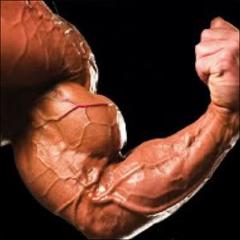The Science Behind: ‘Syntherol – Site Enhancing Oil

Syntherol™ is a caprylic acid based proprietary formulated sterile site enhancement oil. It is manufactured by a major pharmaceutical company in accordance with the highest level of manufacturing practices. No other seller of site enhancement oil can guarantee that the product they sell is sanitary, hygienic, bottled and sealed under pharmaceutical conditions that assure the health and wellbeing of the end user..
Syntherol™ is a proprietary formula whose constituent parts do not deviate from that which is necessary to effect muscular change as described in the science summarized herein. As a result syntherol™ is highly effective.
No other site enhancement oil currently available can claim to be both pharmaceutically sterile and scientifically effective.
What follows is a summary of the science that makes syntherol™ a muscle building agent and the basic protocol developed by IFBB Pro Big A in regard to applying syntherol™.
What is Fascia?
The fascia is not extremely well studied. It is basically a three-dimensional matrix of tissue which may be thought of as both a body casing or sheath (think about a tight rubber body suit) and a separate deeper tissue which penetrates muscle and is attached to muscle via septa (or offshoots).
Fascia seems to function as a way to transmit applied force information from one muscle grouping to the next. Fascia also seems to function as a method by which the force generated by load is applied to muscle fiber and reduced in bone.
When a muscular contraction occurs fascia or rather fascicle (a fascia bundle of muscle fibers) curves. The greater the contraction the greater the curvature. When this curving takes place pressure is produced on the concave side. Curving of the fascicle increases intramuscular pressure and therefore affects blood flow. In addition fascicle curving reduces the force transmitted to the bone.
So a contracted muscle which bulges can be understood to have increased pressure inward.
There really are two distinct classes of fascia. The superficial fascia (the body wrap) is connected to the dermis and the upper torso is enveloped in this tissue from the pectorals to the rib cage area & stomach, up under the lats, from the pectorals up over the delts and down the arms.
This body sheath is capable of transmitting information to various parts of the body concerning the amount of pressure that is occurring on other regions of the body as a result of force generation.
The second class of fascia is specific to the region and yet this deeper tissue also connects to other regions as described above and transmits force/pressure data. The pectoral fascia is firmly connected to the underlying muscle by many intramuscular septa, which originate from the inner surface of the fascia and penetrate between the muscular fibers, dividing the muscle itself into many bundles.
Pectoral fascia thickness varies greatly between people. The lower pectoral fascia is thicker then the upper with the upper pectorial region averaging .49mm in thickness and the lower averaging .60mm in thickness.
There is a significant deviation from these averages in both the thickness & pliability among individuals. One study found lower pectoral fascia thickness varied from a high of .99mm to a low of .24mm.
So from this brief summary we can understand that:
There is a wide variability in fascia thickness and this in part can explain the difference in fullness of muscle bellies between individuals that lift weights.
We can visualize that application of oil will apply pressure to the fascia as it creates curvature even at rest.
We can further visualize that application of oil will increase pressure in the region and as a result increase blood flow.
Consequently if you follow weightlifting lifting techniques that maximize the generation of peak force on a targeted muscle you will also be creating additional maximum pressure inside the muscle worked.
Below are three images showing the superficial fascia (the body wrap); the pectoral fascia; and an image demonstrating how fascia coordinates balance and contraction between the two pectoral sides.
